fuel filter RENAULT KANGOO 2012 X61 / 2.G Owners Manual
[x] Cancel search | Manufacturer: RENAULT, Model Year: 2012, Model line: KANGOO, Model: RENAULT KANGOO 2012 X61 / 2.GPages: 237, PDF Size: 8.62 MB
Page 60 of 237
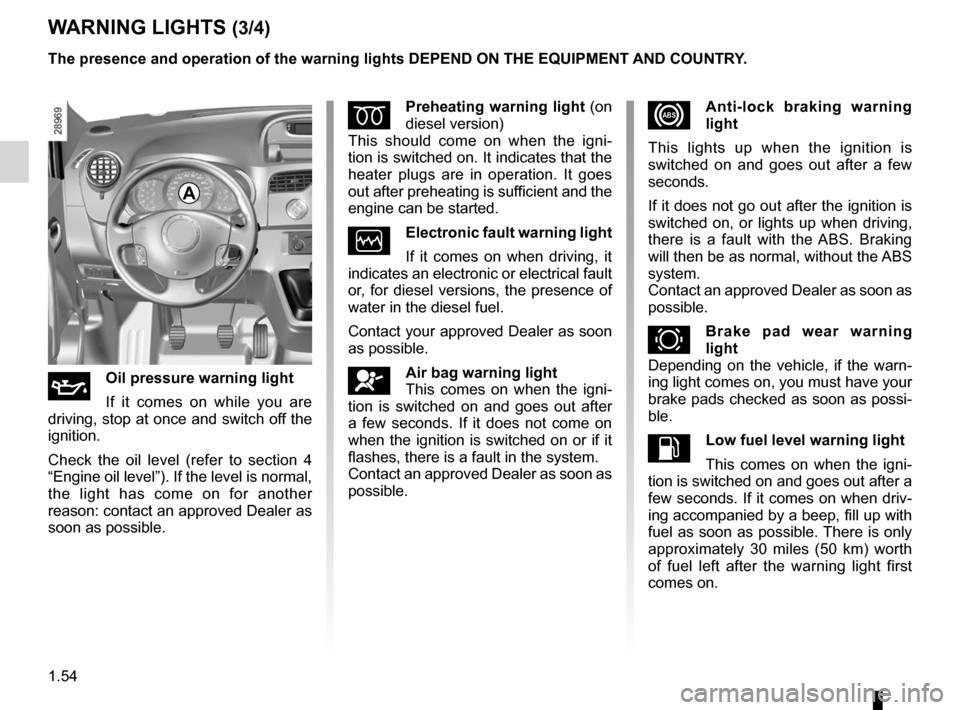
engine oil ............................................................... (current page)
battery .................................................................... (current page)
speed limiter .......................................................... (current page)
cruise control ......................................................... (current page)
ASR (traction control) ............................................ (current page)
filter particle filter ..................................................... (current page)
ESP: Electronic Stability Program ........ (up to the end of the DU)
1.54
ENG_UD24365_6
Tableau de bord : témoins lumineux (X61 - F61 - K61 - Renault)
ENG_NU_813-11_FK61_Renault_1
Jaune NoirNoir texte
WARNING LIGHTS (3/4)
A
The presence and operation of the warning lights DepeND ON THe eQUIpMeNT AND COUNTR y.
xAnti-lock braking warning
light
This lights up when the ignition is
switched on and goes out after a few
seconds.
If it does not go out after the ignition is
switched on, or lights up when driving,
there is a fault with the ABS. Braking
will then be as normal, without the ABS
system.
Contact an approved Dealer as soon as
possible.
\b Brake pad wear warning
light
Depending on the vehicle, if the warn-
ing light comes on, you must have your
brake pads checked as soon as possi-
ble.
LLow fuel level warning light
This comes on when the igni -
tion is switched on and goes out after a
few seconds. If it comes on when driv-
ing accompanied by a beep, fill up with
fuel as soon as possible. There is only
approximately 30 miles (50 km) worth
of fuel left after the warning light first
comes on.
Épreheating warning light (on
diesel version)
This should come on when the igni -
tion is switched on. It indicates that the
heater plugs are in operation. It goes
out after preheating is sufficient and the
engine can be started.
Òelectronic fault warning light
If it comes on when driving, it
indicates an electronic or electrical fault
or, for diesel versions, the presence of
water in the diesel fuel.
Contact your approved Dealer as soon
as possible.
åAir bag warning light
This comes on when the igni -
tion is switched on and goes out after
a few seconds. If it does not come on
when the ignition is switched on or if it
flashes, there is a fault in the system.
Contact an approved Dealer as soon as
possible.
ÀOil pressure warning light
If it comes on while you are
driving, stop at once and switch off the
ignition.
Check the oil level (refer to section 4
“Engine oil level”). If the level is normal,
the light has come on for another
reason: contact an approved Dealer as
soon as possible.
Page 72 of 237
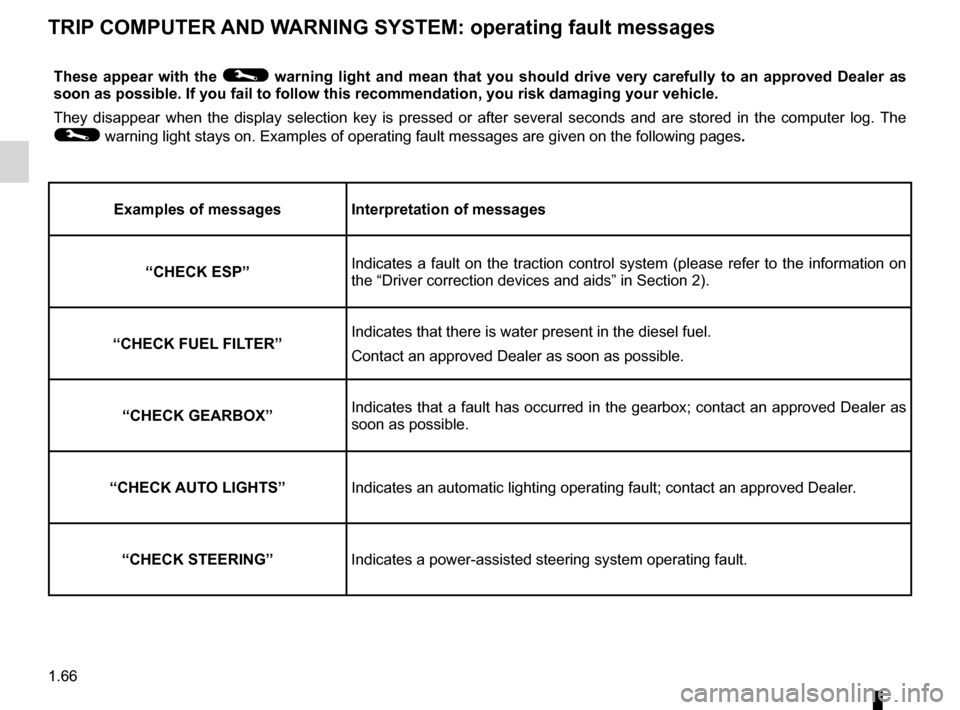
trip computer and warning system.........................(current page)
instrument panel messages ...................................(current page)
warning lights ......................................................... (current page)
instrument panel .................................................... (current page)
1.66
ENG_UD26591_3
Ordinateur de bord : messages d’anomalies de fonctionnement (X85 - X61 - F61 - K61 - Renault)
ENG_NU_813-11_FK61_Renault_1
These appear with the © warning light and mean that you should drive very carefully to an approved Dealer as
soon as possible. If you fail to follow this recommendation, you risk damaging your vehicle.
They disappear when the display selection key is pressed or after several seconds and are stored in the computer log. The
© warning light stays on. Examples of operating fault messages are given on the following pages .
examples of messages Interpretation of messages
“CHeCK eSp” Indicates a fault on the traction control system (please refer to the information on
the “Driver correction devices and aids” in Section 2).
“CHeCK FUeL FILTeR” Indicates that there is water present in the diesel fuel.
Contact an approved Dealer as soon as possible.
“CHeCK GeARBOX ”Indicates that a fault has occurred in the gearbox; contact an approved Dealer as
soon as possible.
“CHeCK AUTO LIGHTS ”Indicates an automatic lighting operating fault; contact an approved Dealer .
“CHeCK STeeRING” Indicates a power-assisted steering system operating fault.
TRIp COMpUTeR AND WARNING SySTeM: operating fault messages
Page 85 of 237
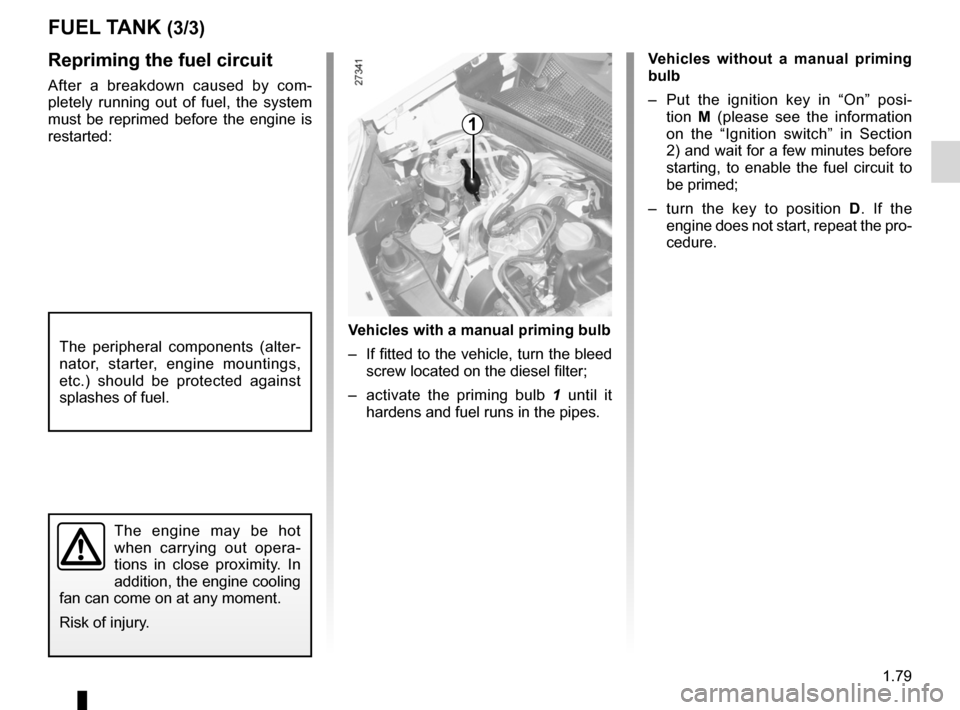
JauneNoirNoir texte
1.79
ENG_UD25777_8
Réservoir carburant (X61 - F61 - K61 - Renault)
ENG_NU_813-11_FK61_Renault_1
Repriming the fuel circuit
After a breakdown caused by com -
pletely running out of fuel, the system
must be reprimed before the engine is
restarted:
The engine may be hot
when carrying out opera -
tions in close proximity. In
addition, the engine cooling
fan can come on at any moment.
Risk of injury.
The peripheral components (alter -
nator, starter, engine mountings,
etc.) should be protected against
splashes of fuel.
v ehicles with a manual priming bulb
– If fitted to the vehicle, turn the bleed
screw located on the diesel filter;
– activate the priming bulb 1 until it
hardens and fuel runs in the pipes.
1
FUeL TANK (3/3)
v ehicles without a manual priming
bulb
– Put the ignition key in “On” posi -
tion M (please see the information
on the “Ignition switch” in Section
2) and wait for a few minutes before
starting, to enable the fuel circuit to
be primed;
– turn the key to position D. If the
engine does not start, repeat the pro-
cedure.
Page 91 of 237
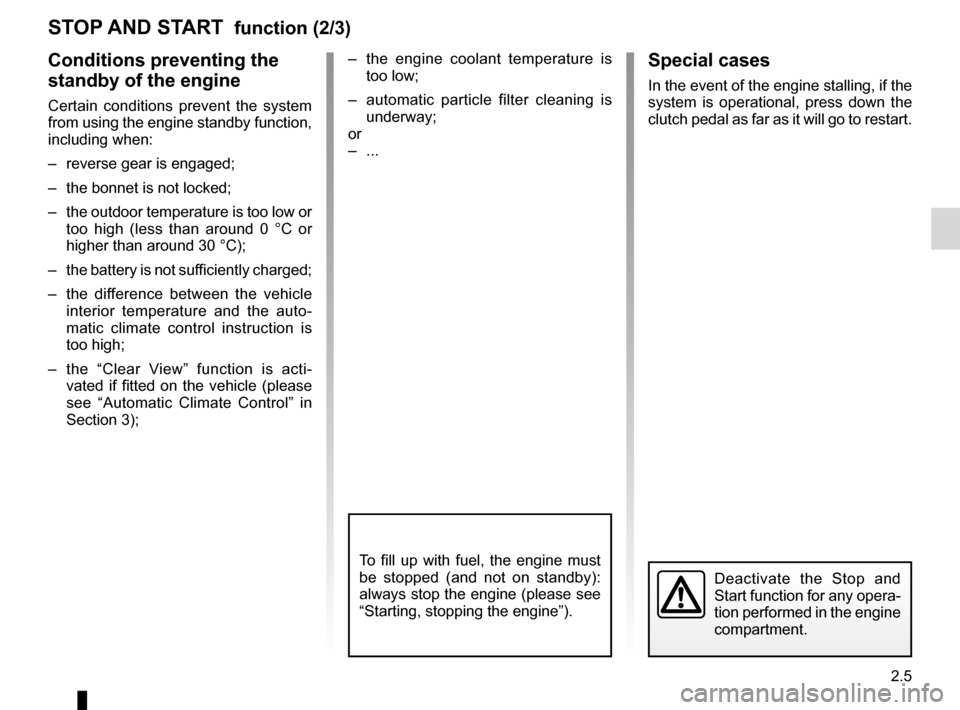
JauneNoirNoir texte
2.5
ENG_UD29639_2
Fonction Stop and Start (X61 - F61 - K61 - Renault)
ENG_NU_813-11_FK61_Renault_2
STOP AND START function (2/3)
Special cases
In the event of the engine stalling, if the
system is operational, press down the
clutch pedal as far as it will go to restart.
Deactivate the Stop and
Start function for any opera -
tion performed in the engine
compartment.
Conditions preventing the
standby of the engine
Certain conditions prevent the system
from using the engine standby function,
including when:
– reverse gear is engaged;
– the bonnet is not locked;
– the outdoor temperature is too low or
too high (less than around 0 °C or
higher than around 30 °C);
– the battery is not sufficiently charged;
– the difference between the vehicle
interior temperature and the auto -
matic climate control instruction is
too high;
– the “Clear View” function is acti -
vated if fitted on the vehicle (please
see “Automatic Climate Control” in
Section 3); –
the engine coolant temperature is
too low;
– automatic particle filter cleaning is
underway;
or
– ...
To fill up with fuel, the engine must
be stopped (and not on standby):
always stop the engine (please see
“Starting, stopping the engine”).
Page 96 of 237
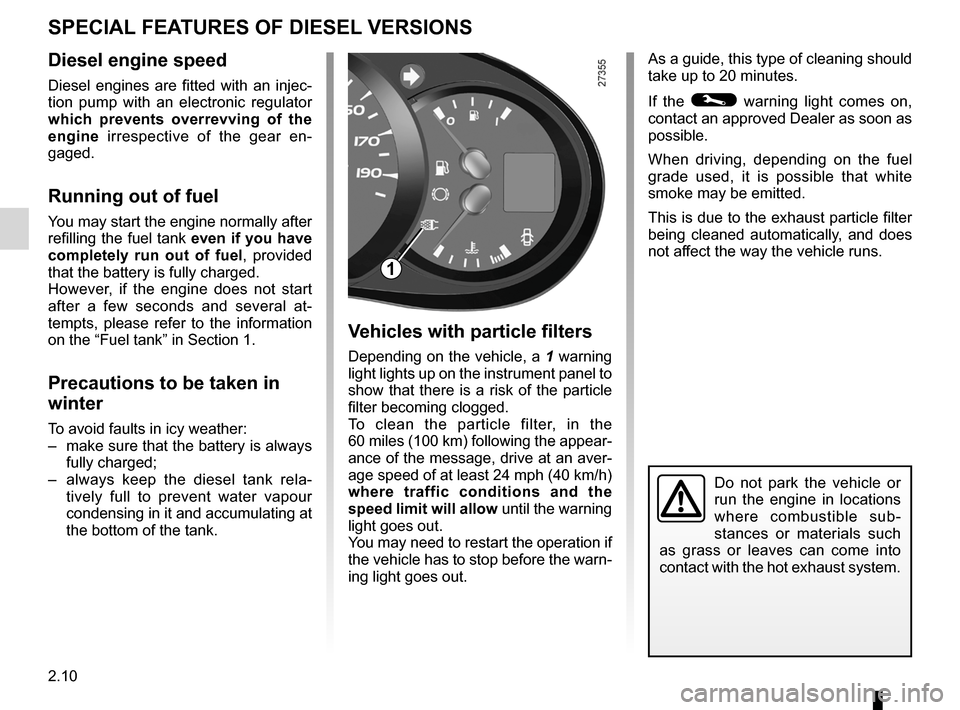
special features of diesel versions........(up to the end of the DU)
2.10
ENG_UD29640_4
Particularités versions diesel (X61 - F61 - K61 - Renault)
ENG_NU_813-11_FK61_Renault_2
Special features of diesel versions
Vehicles with particle filters
Depending on the vehicle, a 1 warning
light lights up on the instrument panel to
show that there is a risk of the particle
filter becoming clogged.
To clean the particle filter, in the
60 miles (100 km) following the appear -
ance of the message, drive at an aver-
age speed of at least 24 mph (40 km/h)
where traffic conditions and the
speed limit will allow until the warning
light goes out.
You may need to restart the operation if
the vehicle has to stop before the warn-
ing light goes out.
Diesel engine speed
Diesel engines are fitted with an injec -
tion pump with an electronic regulator
which prevents overrevving of the
engine irrespective of the gear en -
gaged.
Running out of fuel
You may start the engine normally after
refilling the fuel tank even if you have
completely run out of fuel , provided
that the battery is fully charged.
However, if the engine does not start
after a few seconds and several at -
tempts, please refer to the information
on the “Fuel tank” in Section 1.
Precautions to be taken in
winter
To avoid faults in icy weather:
– make sure that the battery is always
fully charged;
– always keep the diesel tank rela -
tively full to prevent water vapour
condensing in it and accumulating at
the bottom of the tank.
SPECIAl fEATURES Of DIESEl VERSIONS
1
As a guide, this type of cleaning should
take up to 20 minutes.
If the
© warning light comes on,
contact an approved Dealer as soon as
possible.
When driving, depending on the fuel
grade used, it is possible that white
smoke may be emitted.
This is due to the exhaust particle filter
being cleaned automatically, and does
not affect the way the vehicle runs.
Do not park the vehicle or
run the engine in locations
where combustible sub -
stances or materials such
as grass or leaves can come into
contact with the hot exhaust system.
Page 97 of 237
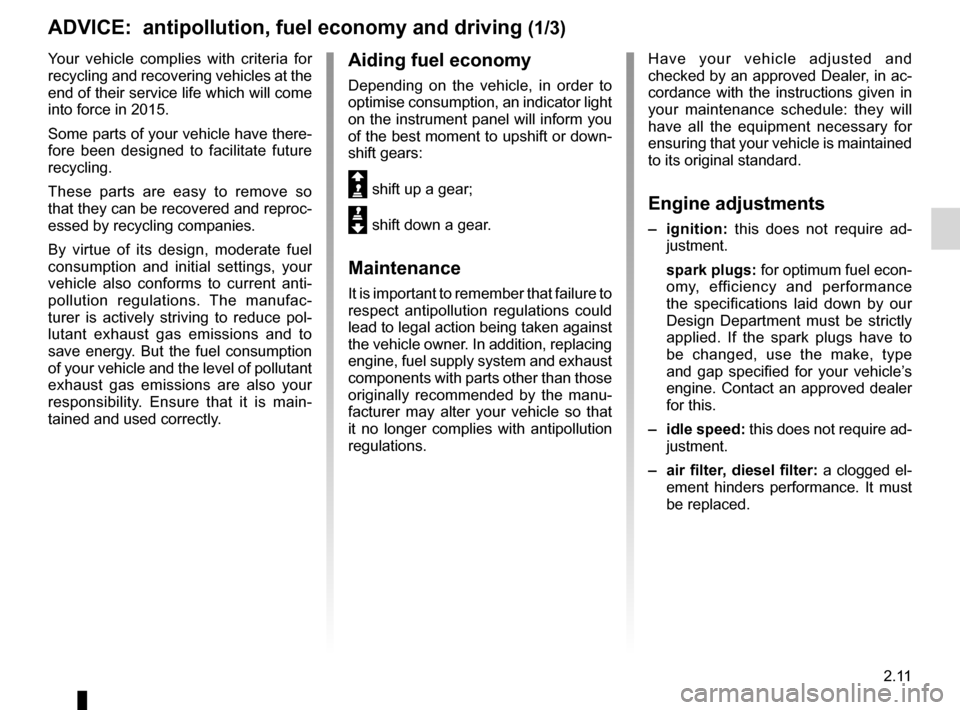
antipollutionadvice ............................................. (up to the end of the DU)
fuel advice on fuel economy .................. (up to the end of the DU)
fuel economy ........................................ (up to the end of the DU)
2.11
ENG_UD21480_4
Conseils : antipollution, économies de carburant, conduite (X83 - X61 - Renault)
ENG_NU_813-11_FK61_Renault_2
Advice on antipollution, fuel economy and driving
ADVICE: antipollution, fuel economy and driving (1/3)
Your vehicle complies with criteria for
recycling and recovering vehicles at the
end of their service life which will come
into force in 2015.
Some parts of your vehicle have there-
fore been designed to facilitate future
recycling.
These parts are easy to remove so
that they can be recovered and reproc-
essed by recycling companies.
By virtue of its design, moderate fuel
consumption and initial settings, your
vehicle also conforms to current anti-
pollution regulations. The manufac -
turer is actively striving to reduce pol -
lutant exhaust gas emissions and to
save energy. But the fuel consumption
of your vehicle and the level of pollutant
exhaust gas emissions are also your
responsibility. Ensure that it is main -
tained and used correctly. Have your vehicle adjusted and
checked by an approved Dealer, in ac-
cordance with the instructions given in
your maintenance schedule: they will
have all the equipment necessary for
ensuring that your vehicle is maintained
to its original standard.
Engine adjustments
–
ignition: this does not require ad -
justment.
spark plugs: for optimum fuel econ-
omy, efficiency and performance
the specifications laid down by our
Design Department must be strictly
applied. If the spark plugs have to
be changed, use the make, type
and gap specified for your vehicle’s
engine. Contact an approved dealer
for this.
– idle speed: this does not require ad-
justment.
– air filter, diesel filter: a clogged el-
ement hinders performance. It must
be replaced.
Aiding fuel economy
Depending on the vehicle, in order to
optimise consumption, an indicator light
on the instrument panel will inform you
of the best moment to upshift or down -
shift gears:
Š shift up a gear;
‰ shift down a gear.
Maintenance
It is important to remember that failure to
respect antipollution regulations could
lead to legal action being taken against
the vehicle owner. In addition, replacing
engine, fuel supply system and exhaust
components with parts other than those
originally recommended by the manu -
facturer may alter your vehicle so that
it no longer complies with antipollution
regulations.
Page 100 of 237
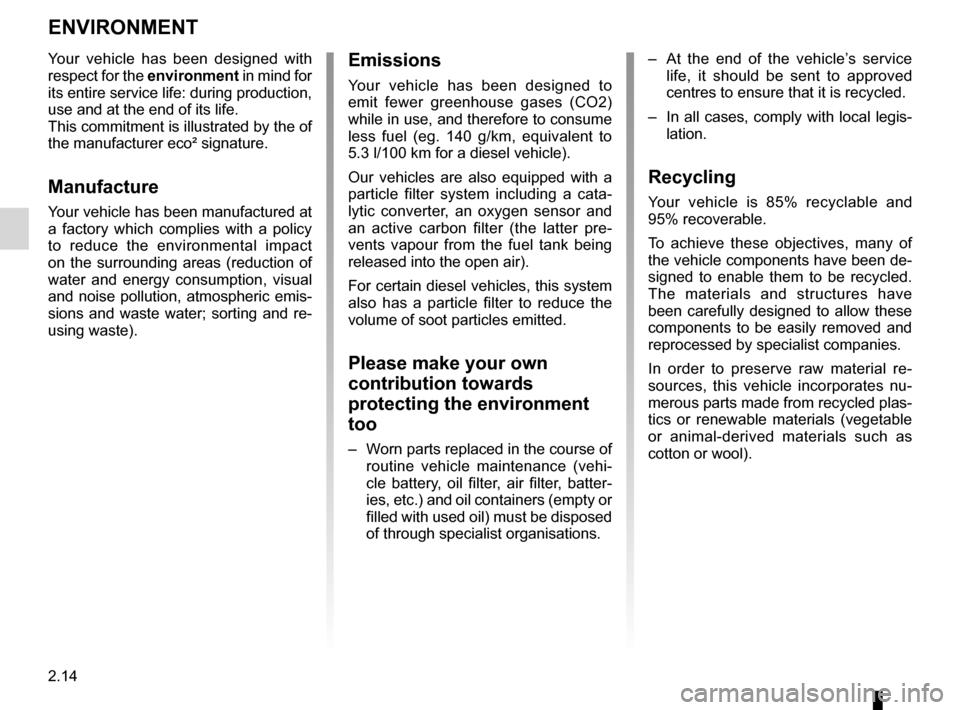
environment .......................................... (up to the end of the DU)
2.14
ENG_UD25716_1
Environnement (sans marque) (X44 - X45 - X77 - X81 - X85 - X90 - X91 - X83 - X61 - TEST - X95 - J95 - R95 - F90 Ph2 - X33 - X47 - X43 - X38 - H79 - X62 - X32 - X09 -
ENG_NU_813-11_FK61_Renault_2
Environment
ENVIRONMENT
Emissions
Your vehicle has been designed to
emit fewer greenhouse gases (CO2)
while in use, and therefore to consume
less fuel (eg. 140 g/km, equivalent to
5.3 l/100 km for a diesel vehicle).
Our vehicles are also equipped with a
particle filter system including a cata -
lytic converter, an oxygen sensor and
an active carbon filter (the latter pre -
vents vapour from the fuel tank being
released into the open air).
For certain diesel vehicles, this system
also has a particle filter to reduce the
volume of soot particles emitted.
Please make your own
contribution towards
protecting the environment
too
– Worn parts replaced in the course of
routine vehicle maintenance (vehi -
cle battery, oil filter, air filter, batter -
ies, etc.) and oil containers (empty or
filled with used oil) must be disposed
of through specialist organisations. –
At the end of the vehicle’s service
life, it should be sent to approved
centres to ensure that it is recycled.
– In all cases, comply with local legis -
lation.
Recycling
Your vehicle is 85% recyclable and
95% recoverable.
To achieve these objectives, many of
the vehicle components have been de-
signed to enable them to be recycled.
The materials and structures have
been carefully designed to allow these
components to be easily removed and
reprocessed by specialist companies.
In order to preserve raw material re -
sources, this vehicle incorporates nu -
merous parts made from recycled plas-
tics or renewable materials (vegetable
or animal-derived materials such as
cotton or wool).
Your vehicle has been designed with
respect for the
environment in mind for
its entire service life: during production,
use and at the end of its life.
This commitment is illustrated by the of
the manufacturer eco² signature.Manufacture
Your vehicle has been manufactured at
a factory which complies with a policy
to reduce the environmental impact
on the surrounding areas (reduction of
water and energy consumption, visual
and noise pollution, atmospheric emis-
sions and waste water; sorting and re-
using waste).
Page 131 of 237
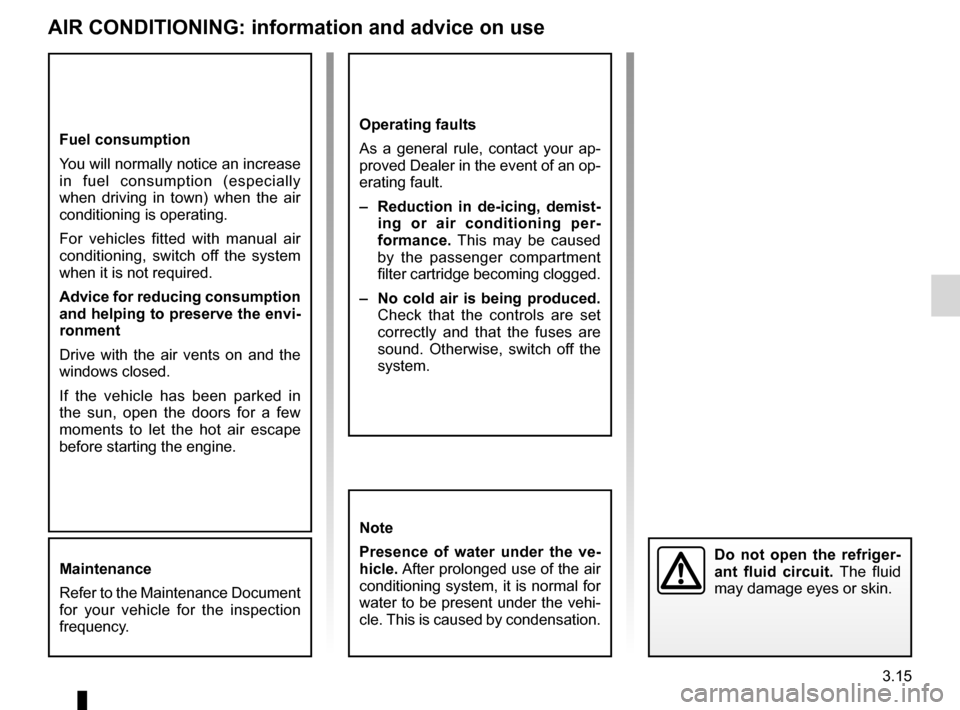
air conditioning ..................................... (up to the end of the DU)
heating system ..................................... (up to the end of the DU)
air conditioning ..................................... (up to the end of the DU)
temperature regulation ......................... (up to the end of the DU)
ventilation ............................................. (up to the end of the DU)
heating and air conditioning system ..... (up to the end of the DU)
3.15
ENG_UD10048_2
Air conditionné : informations et conseils d’utilisation (X61 - F61 - K61 - Renault)
ENG_NU_813-11_FK61_Renault_3
Air conditioning: information and advice on use
Operating faults
As a general rule, contact your ap-
proved Dealer in the event of an op-
erating fault.
– r eduction in de-icing, demist -
ing or air conditioning per -
formance. This may be caused
by the passenger compartment
filter cartridge becoming clogged.
– no cold air is being produced.
Check that the controls are set
correctly and that the fuses are
sound. Otherwise, switch off the
system.Fuel consumption
You will normally notice an increase
in fuel consumption (especially
when driving in town) when the air
conditioning is operating.
For vehicles fitted with manual air
conditioning, switch off the system
when it is not required.
Advice for reducing consumption
and helping to preserve the envi-
ronment
Drive with the air vents on and the
windows closed.
If the vehicle has been parked in
the sun, open the doors for a few
moments to let the hot air escape
before starting the engine.
Air COnDitiOninG: information and advice on use
note
Presence of water under the ve -
hicle. After prolonged use of the air
conditioning system, it is normal for
water to be present under the vehi-
cle. This is caused by condensation.
Do not open the refriger -
ant fluid circuit. The fluid
may damage eyes or skin.Maintenance
Refer to the Maintenance Document
for your vehicle for the inspection
frequency.
Page 162 of 237
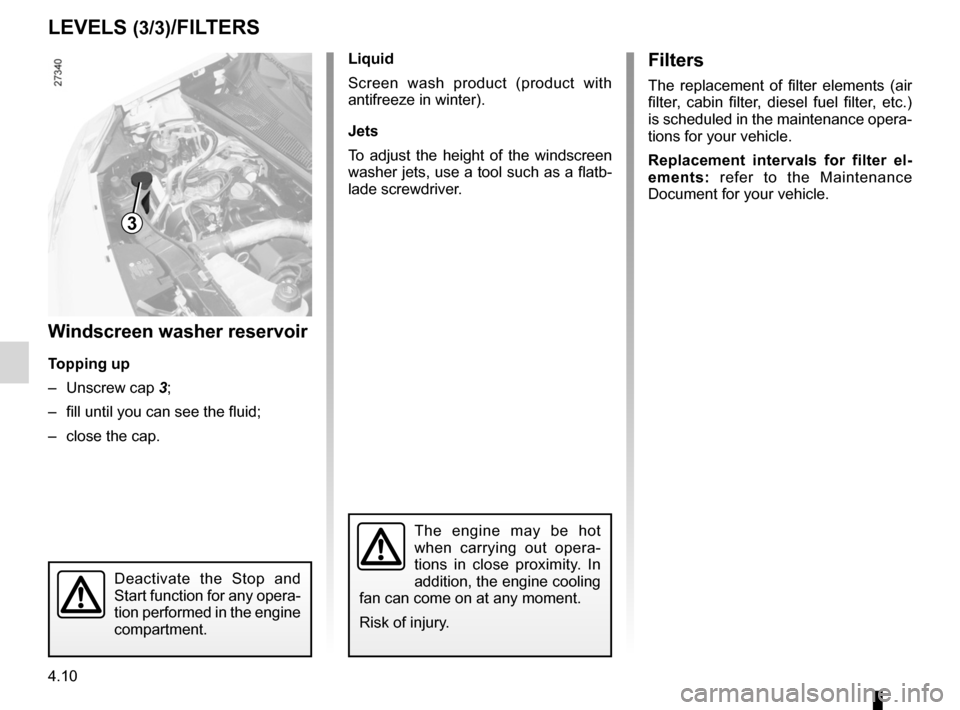
levels:windscreen washer reservoir ........................... (current page)
filter ........................................................................\
(current page)
windscreen washer fluid ........................................ (current page)
4.10
ENG_UD25825_5
Niveaux / Filtres (X61 - F61 - K61 - Renault)
ENG_NU_813-11_FK61_Renault_4
levelS (3/3)/FIlteRS
Filters
Windscreen washer reservoir
t opping up
– Unscrew cap 3;
– fill until you can see the fluid;
– close the cap. liquid
Screen wash product (product with
antifreeze in winter).
Jets
To adjust the height of the windscreen
washer jets, use a tool such as a flatb-
lade screwdriver.
Filters
The replacement of filter elements (air
filter, cabin filter, diesel fuel filter, etc.)
is scheduled in the maintenance opera
-
tions for your vehicle.
Replacement intervals for filter el -
ements: refer to the Maintenance
Document for your vehicle.
The engine may be hot
when carrying out opera -
tions in close proximity. In
addition, the engine cooling
fan can come on at any moment.
Risk of injury.
3
Deactivate the Stop and
Start function for any opera -
tion performed in the engine
compartment.
Page 232 of 237
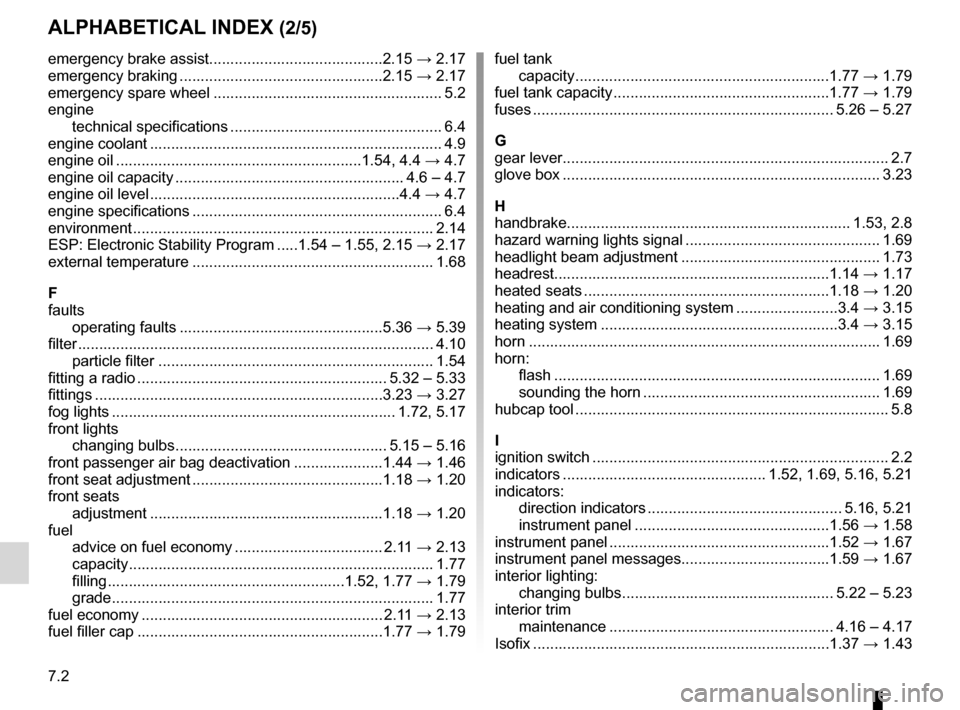
7.2
FRA_UD29767_11
Index (X61 - F61 - K61 - Renault)
ENG_NU_813-11_FK61_Renault_7
Jaune NoirNoir texte
AlphAbeticAl index (2/5)
emergency brake assist ......................................... 2.15 → 2.17
emergency braking ................................................ 2.15 → 2.17
emergency spare wheel ...................................................... 5.2
engine technical specifications .................................................. 6.4
engine coolant ..................................................................... 4.9
engine oil .......................................................... 1.54, 4.4 → 4.7
engine oil capacity ...................................................... 4.6 – 4.7
engine oil level ........................................................... 4.4 → 4.7
engine specifications ........................................................... 6.4
environment ....................................................................... 2.14
ESP: Electronic Stability Program .....1.54 – 1.55, 2.15 → 2.17
external temperature ......................................................... 1.68
F
faults operating faults ................................................ 5.36 → 5.39
filter .................................................................................... 4.10
particle filter ................................................................. 1.54
fitting a radio ........................................................... 5.32 – 5.33
fittings .................................................................... 3.23 → 3.27
fog lights ................................................................... 1.72, 5.17
front lights changing bulbs .................................................. 5.15 – 5.16
front passenger air bag deactivation ..................... 1.44 → 1.46
front seat adjustment ............................................. 1.18 → 1.20
front seats adjustment .......................................................1.18 → 1.20
fuel advice on fuel economy ................................... 2.11 → 2.13
capacity ........................................................................ 1.77
filling ........................................................ 1.52, 1.77 → 1.79
grade ............................................................................ 1.77
fuel economy ......................................................... 2.11 → 2.13
fuel filler cap .......................................................... 1.77 → 1.79fuel tank
capacity ............................................................ 1.77 → 1.79
fuel tank capacity ................................................... 1.77 → 1.79
fuses ....................................................................... 5.26 – 5.27
G
gear lever ............................................................................. 2.7
glove box ........................................................................... 3.23
h
handbrake ................................................................... 1.53, 2.8
hazard warning lights signal .............................................. 1.69
headlight beam adjustment ............................................... 1.73
headrest ................................................................. 1.14 → 1.17
heated seats .......................................................... 1.18 → 1.20
heating and air conditioning system ........................ 3.4 → 3.15
heating system ........................................................ 3.4 → 3.15
horn ................................................................................... 1.69
horn: flash ............................................................................. 1.69
sounding the horn ........................................................ 1.69
hubcap tool .......................................................................... 5.8
i
ignition switch ...................................................................... 2.2
indicators ................................................ 1.52, 1.69, 5.16, 5.21
indicators: direction indicators .............................................. 5.16, 5.21
instrument panel .............................................. 1.56 → 1.58
instrument panel .................................................... 1.52 → 1.67
instrument panel messages ...................................1.59 → 1.67
interior lighting: changing bulbs .................................................. 5.22 – 5.23
interior trim maintenance ..................................................... 4.16 – 4.17
Isofix ...................................................................... 1.37 → 1.43